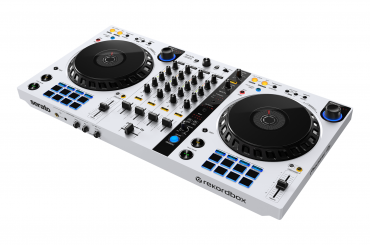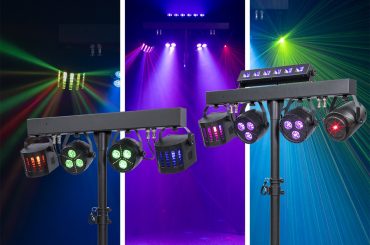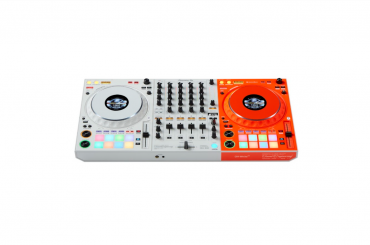There’s no question that there are a lot of DJ controllers on the market these days — all-in-one control and audio interface solutions, generally built around a specific DJ software application. And in the past couple of years, it appears that New Zealand-based Serato has become the application of choice for bundling with new controllers to hit the market.
I must confess that it makes my job as a reviewer just a bit easier in some ways. I have my Mac-based DJ controller test bed set-up, I’m familiar with and regularly use Serato, and pretty much all I have to do is unplug one, and plug in another. The downside, however, is that a lot of the controllers that hit my hardware review bench begin to look a lot the same.
I have to confess as well, then, that when the Numark NS6II arrived, I had a slight bit of a “well, here’s another one” reaction. It was upon closer inspection, however, that I began to see the NS6II for what it is: a robust, Serato-based DJ controller with some design choices that make it particularly suitable for the true, working DJ.
First Impressions: Numark is part of the inMusic Brands family, which aggressively pursues the DJ market from no less than three different angles, and three different brands: Numark, Denon DJ, and more recently, Rane. It’s readily apparent that understanding the DJ market as well as the company certainly must does result in some interesting thinking when it comes to product design. Either that, or Numark has been reading my reviews over the years, because they’ve crossed off just about every “nit” complaint I’ve made in print about DJ controllers. I’ll explain that in more detail as we go along.
Inspecting the NS6II after unboxing, I find a lot of duality. Dual USB connections. Dual external inputs. Dual master outs. Dual mic inputs. Dual circular digital displays in the centers of the dual platters; you get the idea.
Dual mic inputs… that is something I mention (or complain about) a lot, because in mobile DJ environments, I find it essential, and I think any mobile jock would agree. Take the typical wedding gig for example; I always need an MC mic for myself, and a wireless handheld to give the best man or maid of honor to do their things, for guests to make toasts, and so on. While I suppose you could do that with a single wireless system connected to a single mic input on the controller, call me “old school” — I just like using my trusty, great-sounding, hard-wired SM58 and a wireless system for everyone else. As a result, on the NS6II, I dig that there are not just dual inputs, but dual, front-panel controls that are identical for each, including dual-band EQ and level. I would have liked to have seen on/off buttons as well, but hey, I can twist a knob, and Numark needs ideas for the NS6III, right?
While I don’t have my testbed set-up to evaluate it, the NS6II provides (as noted above) two USB host connections. According to Numark, this allows a single NS6II to be connected simultaneously to two laptops. Each side of the unit has a toggle to indicate which laptop is active, providing the ability to play the last track of one DJ’s set from one side, mix seamlessly to the first track of the next DJ on the other side, then disconnect the exiting DJ and keep going. Definitely an innovative way to transition jocks midstream.
The dual master outs on the back include RCA and XLR — the latter clearly telegraphing the intended market for the NS6II. The RCA inputs for external sound sources further make that point and are also essential to me for mobile gigs where I tend to mix from multiple sources, including computer-based files (in Serato DJ), as well as external devices, and often CDJs as well; I like the flexibility.
Speaking of duality, each “side” acts as two decks, for a total of four. The NS6II provides all four channels broken out with EQ and level sliders. Decks 3 and 4 can be set for “PC,” which means they’re virtual decks in Serato DJ, or as I suggested earlier, can be set to “Line” for external signal sources.
Finally, Numark’s design ethos is in clear evidence here, too. The predominantly red backlighting against the sleek, black, aluminum top does make a statement. (The underside of the controller is plastic, but I like the primary wear surfaces being metal.)
Set-Up & Use: For me, anyway, set-up of the NS6II couldn’t possibly have been faster, or simpler. Plug in the power. Plug in the monitors I have in my testbed. Connect the USB cable to my Mac. Load Serato DJ. In roughly 90 seconds start-to-finish, I was mixing my first set with the unit.
Of course, those who don’t already have Serato DJ in place will find that the unit unlocks the full version of that software and getting going is really little more involved than downloading the software online. Obviously, new Serato DJ users will also have to contend with getting their music library loaded as well, but that’s not exactly rocket science either. The fact that the NS6II was plug-and-play means that Numark has made all of this as simple as possible.
Using the NS6II hands-on is where things get pretty much industry-standard, aside from some notable extras that Numark’s designed in. That’s a positive in a lot of ways, because it makes it possible for experienced DJs to use the gear without cracking the manual. It’s only a negative because DJ controllers can start to seem all alike.
But the NS6II still differentiates itself. Along with the laundry list I provided earlier, the unit provides a few niceties that round things out. Among them are needle-drop, touch-sensitive strips, one of each side, for quickly moving the playback point. Additionally, you’ll find round LCD color displays in the center of each of the two rotary encoding platters. The displays show BPM, time remaining, and percentage of pitch modification — not to mention a visual, segment display indication of relative track position. Critically, the display also shows its toggle state; left side between deck 1 and 3, right side between deck 2 and 4.
Those platters, by the way, have a terrific feel. Solid, perfectly sized, and they feel like most CDJs I’ve used, providing accurate, intuitive control and responsiveness.
Each of the four channels has a combined high-/low-pass filter. It’s nice having them in hardware; of course, Serato DJ offers HPF and LPF in its effects engine as well. And speaking of effects, the NS6II provides four knobs and four buttons on each side of the unit to intuitively control that effects engine.
Numark’s implementation of queuing, looping, slicing, etc., is very much like that of its competitors; there are eight drum-pad like buttons under each platter, along with mode-switching buttons. DJs accustomed to Serato DJ and this particular control approach will feel at home. Call me old-school (again), but I’ve never really liked unlabeled, multi-mode, multi-purpose buttons. Still, I confess… I’m the odd man out on this topic – most DJs are just fine with it.
If that complaint was a nit, so is this: There’s not a tactile center detent on the pitch sliders. The only way to know that the slider is neutral is to visually look for the white LED indictor that’s adjacent to the center position to light up. I usually adjust pitch by feel, and not having that tactile indication of neutral/center feels like an oversight to me. Again, maybe Numark can put that on the list for the NS6III when it’s time.
Conclusion: As I said at the outset, it’s clear from the feature set that Numark is targeting real, working DJs with the NS6II, and the street price of roughly $800 definitely aligns with that target. While it might lack some of the truly high-end features of more expensive competitors (like color LCD displays and standalone media playback without a computer), for the price, and the feature set, there’s a lot to like in this capable, workhorse DJ controller. Nicely built, nicely appointed, a joy to use, and ideal for mobile jocks, Numark’s new NS6II is definitely one to consider.








